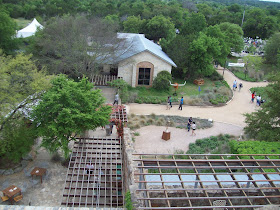Every landscape contains some plants that will not grow unless they have gone through fire. These seed lay dormant, awaiting their call to action - awaiting the moment God created them for - and burst into life on burnt ground in due time.
But some locations, such as steep slopes that burned with a kiln-hot blaze, may need a little help. Especially, those prone to erosion may benefit from an extra supply of native grasses (pdf link here) mirroring those in place before the burn, so that the root systems can hold the soil in place.
One of Texas' native plant suppliers, "Native American Seed"aka SeedSource.com, has created a Wildfire Reference Guide that provides information, links to resources, tips and seed recommendations. This company has loads of information about effective use of native grasses in landscaping and in prairie restoration.
Another excellent website is "Firewise", sponsored by the National Fire Protection Association. Lots and lots of information, not only for professionals, but also excellent resources for homeowners. One full page is dedicated to tips for wildfire readiness & evacuation. Another shares plant lists provided by various State Extension Services.
The NFPA's preparedness efforts include "Ready, Set, Go!" Most of these readiness habits are important for any emergency evacuation, so it's worth reading even if you don't live in a wildfire-prone area.
We're "not out of the woods yet", but the future calls. Time to get to work on a Texas landscape that's on the mend, that will overcome the continuing drought. Although this drought that affects the entire states of Texas & Oklahoma, much of New Mexico, and even part of Louisiana, is not expected to end for another year, the Good Lord sends us rain to tide us over until the fullness of time in this natural cycle.
So now, in time for fall and winter moisture, is a good time for scattering locally-native wild seed.
We have not had major fires in our area this year. Our ecology suffers from the lack of moisture, heat and dehydration. As the rest of my St Augustine lawn dies under heavy water rationing, as have 2 mature apricot trees, a young apple tree, three young grapes, asparagus, herbs, and several perennials, I'm starting to think how to reconstruct our yard once the drought ends. And what I'm thinking is wild.
In addition to the resources mentioned above, the always-remarkable Texas Parks & Wildlife department has a great program for increasing our backyard & urban habitats called "Texas Wildscapes".
Last but not in any way least, the Lady Bird Johnson Wildflower Center has a Drought Resource Center that is especially inspiring and hope-filling right now.
The one nice thing about this summer has been not having to mow - normally a 3-hour-a-week job. What if, when I put out those new fruit trees on our extra lot, instead of being blanketed with grass that has to be cut, they were surrounded by permanent paths and un-mown, non-irrigated patches of native meadow and lovely wildflowers, like these from our visit to the Lady Bird Johnston Wildflower Center in Austin:
That could be an unexpected blessing indeed!
P.S. Tuesday, Oct 4th, is when Texas hosts National Night Out, and in our town, with no police force, our local Volunteer Fire Department is having open house - yours probably is, too. Drive over to the fire station and visit, shake hands with these uncommon young men in your community. Chances are they've spent many hours fighting or preventing fires this summer.




No comments:
Post a Comment